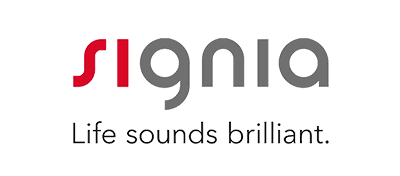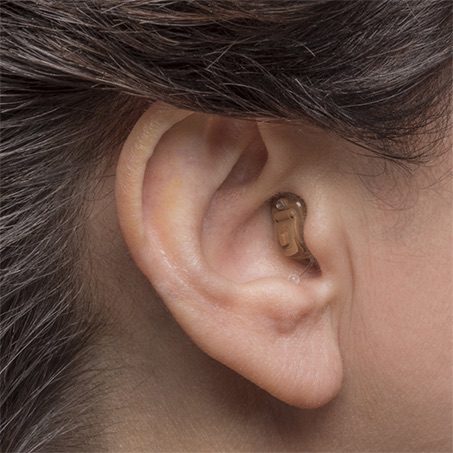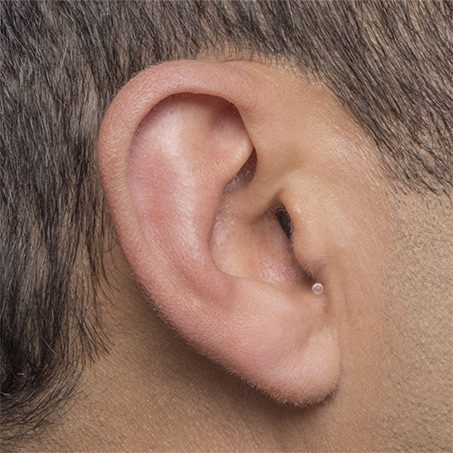Advanced Prescription Hearing Aid Technology to Meet Your Specific Needs
If someone brings up the subject of prescription hearing aids, does your mind immediately envision those ugly, bulky, and frustrating devices your parents or grandparents wore? It’s time to eliminate that outdated stigma from your mind, because modern hearing aid technology is nothing like it was even ten years ago.
For more information on the technology we offer, please click the manufacturer logos below.











You’ve probably witnessed how cell phones have changed in the last decade or so, moving from very basic voice and text digital technology to the extremely advanced smartphones we now carry with us.
Hearing aids have progressed in the same way, allowing hearing aid manufacturers to produce smaller, lighter, more stylish, and more discreet devices.
Just like with smartphones, small packaging doesn’t mean less power.
Thanks to micro digital and nano-digital technology today’s smaller hearing instruments pack the processing power able to provide greater and more natural sound clarity, control background noise, include long-lasting rechargeable batteries, and make it possible to link your hearing aids to other digital devices, like your cellphone, television, and computer.
Today’s prescription hearing aid technology also makes it possible for hearing devices to come in a variety
of different sizes, colors, costs, designs, levels of technology, and range of features, which probably means you’ll be overwhelmed by all the choices available.
Our hearing aid specialists are here to help put your mind at ease and sort things out, while you go through the selection process. We’ll help you narrow down your choice by helping you consider your unique needs and preferences, such as:
- The processing power needed to address your specific level of hearing loss
- Your manual dexterity and visual capabilities
- Your budget limitations
- Your wearing discretion and cosmetic concerns
- Skin sensitivities
- Anatomical/medical considerations
Hearing Aid Styles
- Behind-the-Ear (BTE)
- Receiver-in-Canal (RIC)
- In-the-Ear (ITE)
- In-the-Canal (ITC)
- Completely-In-The-Canal (CIC)
- Invisible-In-the-Canal (IIC)

Behind-the-Ear (BTE)
BTE hearing aids have an appearance that is like older analogue devices, but don’t let that fool you. Along with being lighter and more streamlined, the digital processing power they contain in the processing unit, which sets comfortably behind your ear, far exceeds that of their ancestors. Greater comfort from custom formed earmolds as well as open-canal earpieces to eliminate the “plugged up” feeling some users experience are features that make BTE hearing aids the most flexible, adaptable, and powerful hearing instruments available for all levels of hearing loss. Available as:
- BTE
- Mini BTE

Receiver-in-Canal (RIC)
RIC hearing aids are a type of BTE device modified for a comfortable, open-fit design suited for nearly all types of hearing loss. The main difference between RIC and BTE hearing aids is the location of the instrument’s speaker, which is in the main BTE body, but in the ear tip on an RIC device. They are small, lightweight, and packed with powerful technology to serve those with mild to severe hearing loss. Available as:
- Micro RIC
- RIC

In-the-Ear (ITE)
ITE instruments take the technology from the behind-the-ear processor of BTE/RIC devices and combine it with the speakers in a single molded shell custom fit to the contours of your outer ear canal. Full-shell ITE technology produces powerful, clear sound for all degrees of treatable hearing loss, and is a good choice for those who wear glasses or use an oxygen cannula. Ease of adjustment, larger batteries with a longer life, rechargeability, and a broad choice of colors are among the advantages of ITE hearing aids over smaller devices.

In-the-Canal (ITC)
Smaller versions of ITE devices, ITC hearing aids are molded to fit further into the ear canal instead of the outer ear. They provide many of the same benefits as ITE devices for users who wear glasses, an oxygen cannula, or hats, but make a more active lifestyle possible and allow for greater wearing discretion. Individuals with mild to mildly severe hearing loss can benefit from this style, which includes the capacity to customize external controls to fit your needs.

Completely-In-The-Canal (CIC)
Going deeper into the ear canal, CIC devices have a tiny clear plastic post that allows the wearer to insert them deeper inside the ear canal than ITC devices. Those who lack fine dexterity may struggle with this style of hearing aid, but they provide active wearers with a greater level of comfort and discretion while reducing wind interference for more natural hearing and greater clarity. These devices are only suited for individuals with mild to moderate hearing loss.

Invisible-In-the-Canal (IIC)
Those concerned with wearing discretion enjoy the snug, custom molded fit of IIC hearing devices. Inserted near the second bend of the ear canal, they are 100% invisible, digital, and fully programmable, packing clarity and processing power into the tiniest of spaces. IIC hearing instruments serve those with a very active lifestyle who experience mild to moderate hearing loss and who have the manual dexterity to insert and remove them.
Patient Stories
You Ask, We Answer
How To Use Your Hearing Aids Controls
How Hearing Aids Can Make You Younger
Caring for your Hearing Aids















